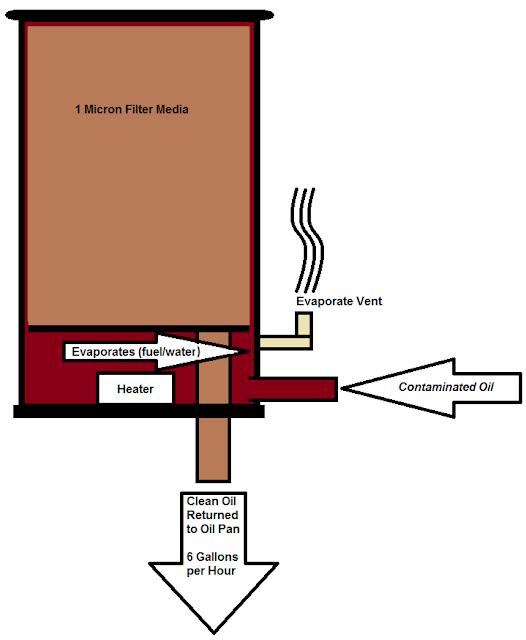Make an Additional $50,000.00 a Year From Your Rig!
Everyone wants to make more money at their job, but very few people have the opportunity to give themselves a $50,000.00 raise per year. You, as an owner/operator of a tractor trailer, have that opportunity. You’ve probably heard any number of these recommendations before, but we’ve put them all together - and done the math. If you want results, some bad habits need to be broken and some equipment needs to be installed. Let’s start with 5 realistic ways you can make much more money with your rig.
Stop Idling!
You and I both know drivers that have bad habits. First, there’s idling. Of the 24 hours available, 11 are over the road and the other 13 are consumed idling – usually just for convenience. While there are any number of reasons to reduce idling as much as possible, including laws in some states, consider this:
· Idling reduces the useful lifetime of your oil. You have a standard lifetime of around 600 hours of operation for over-the-road driving with each oil change. Continuous idling can reduce that to a mere 150 hours! How much are you paying for a standard oil change? How often do you want to be paying for one? Idling at around 625 RPMs allows for buildup of unburned fuel on the cylinder liners, which is drawn in by the oil sump. This contaminates the oil and shortens the life of the fluid as a lubricant. You’re now paying for more oil changes, more fuel and more engine maintenance; this is your money lost. Even if you choose a higher idling rate to combat some of the oil contamination, you’re now using even more fuel to idle, and you’re still paying more for maintenance, so your costs are still piling up.
· You’re not making money from your fuel if you’re idling. Drivers want to drive. That’s how money is made, but there are mandatory down times. What your truck is doing while on that down time is where your money is going; especially since a one-man driver is on downtime more than driving time every single day. Some drivers think of it as a necessary evil, and create the most comfortable environment possible while burning up to a gallon of diesel an hour. That’s almost $50.00 per day in fuel that’s not making you money. Multiply that by the average truck work year, and that’s around $14,000.00. Stop idling unless absolutely necessary and you start making more money.
· So, what do you do about it? Install a small generator that runs from your fuel tank, or a separate tank. You can have a very comfortable cab, as well as run your electrics from a small, very efficient generator. There are also electric plug-ins available at numerous truck stops and rest areas, so drivers can be comfortable in any weather, and the heaters can keep the fluids at start-up temp. It actually takes about 14 hours for an engine and fluids to cool to ambient temperature once the rig is shut down, depending on the outside temperature, so worrying about a cold start usually isn’t the problem. There are a host of other solutions out there as well, from solar, to AC battery solutions that will reduce your idling time significantly.
Break Bad Habits!
Ride with enough drivers and you’ll know most seem to have one or two major fuel wasting habits. The first one is almost always their speed. Yes, the load has to be there on time, and drivers want to get the most miles out of their 11 hours, but what if you knew for a fact that dropping your speed from 75 mph to 65 mph would make you $18,000.00 more per year in fuel savings? That’s right; by dropping an average of 10 mph, drivers can gain as much as 1 additional mpg. The difference between the maximum fuel economy RPM and the maximum horsepower RPM range can be as small as 200 RPM. Find out the range for your truck, and take advantage of it. If your average is 6 mpg, plug in 7 mpg to your yearly fuel usage, and see how much more you can make with your truck/fleet just by slowing it down some.
Another bad habit is running out of the top gear. If you are in the top gear less than 90% of the time, you’re paying for it. Poor shifting habits make for huge losses in fuel. Ten percent less time in the top gear translates into 0.5% mpg losses. And, of course, there’s sudden stopping and fast acceleration to make matters worse. How bad is it? There’s a 30% loss of fuel mileage associated with poor driving habits when a driver exhibits all bad habits at once. Let’s see how that translates into what you could be making. Using our average mileage for an OTR rig of about 6 MPG, with a 30% loss for poor driving, that makes it in the neighborhood of 4.8 MPG. How much do you save with good driving habits? Conservatively, about $30,000.00 per year if you compare fuel usage at each of those values for one year.
You’ll notice we’re well above the $50,000.00 mark at this point, and there’s still more to come. So why am I giving you a lower estimate? Not all drivers, or all trucks, exhibit all of the same problems. Some have good driving habits, but poor idling behaviors; others, vice versa. Still more problems can be isolated to the equipment itself. Which brings us to…
Update Your Equipment!
With the exception of poorly maintained equipment, of all the things that make a truck expensive to operate, the lack of aerodynamics can be one of the worst. If your truck/fleet is still hauling without improvements in aerodynamics, you need to do a cost analysis on the return this equipment provides.
The highest estimate for updating your truck with aerodynamic equipment is that it can add up to 12% to your MPG. That takes your mileage from 6 MPG to 6.76 MPG, with a fuel savings of around $14,000.00 per year. Yes, you will spend several thousand dollars for an upgrade, but that’s a one-time investment that pays you again, and again, over the life cycle of the rig. Additionally, not every upgrade is available for every type of rig, so your results are going to vary with the amount of aerodynamics you can, or do, install. Some equipment you might want to review includes:
A Trailer Gap Reducer and Trailer Side Skirts
A Trailer Boat Tail and Trailer Side Skirts
Advanced Trailer End Fairing
Advanced Trailer Skirts
Tractor Aerodynamics Package
Finally, there are low rolling resistance tires. These tires are already required in California on all tractors, and are a coming requirement for all trailers in that state by 2017. This sounds like bad news, but for the small additional cost of each tire, there are significant returns. Just as the shape of your truck contributes to greater resistance, so does the design of your tire. Low rolling resistance tires can improve your MPG by up to 8%. Again, taking our average rate of 6 MPG, and adding another 8% to the equation gives you around $9,000.00 per year.
If nothing else, this information should help you determine where to begin to start making more money. If we’re being realistic, each item has its own associated expense. If you’re the driver, you’ll have to spend time relearning good driving habits, determining just how much idling you actually have to do, and how much time you are going to spend in down time to do the upgrades on your rig. If you have drivers working for you, you will have training costs; upgrade costs and management expenses to continue a successful program. If you’re interested in making more money from your business, it’s worth it.
East Coast Truck and Trailer Sales
2906 Elmhurst Lane
Portsmouth, VA 23701
800-849-2178













.JPG/800px-Woolbrook_(4).JPG)
